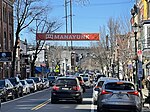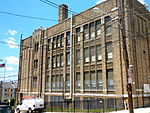St. Josaphat Roman Catholic Church in Philadelphia
St. Josaphat Roman Catholic Church in Philadelphia is located in the Manayunk section of Northwest Philadelphia at 124 Cotton Street. This parish was merged with those of St. John the Baptist and St. Mary of the Assumption in 2012.The church was named in honor of Saint Josaphat, who was born circa 1580 as John Kuncevic in Vladimir, a village of the Lithuanian Province of Volhynia (then a part of the Polish Kingdom begun under the Jagiellonian dynasty), and who rose to increasing positions of authority within the church after professing his faith. Murdered in Vitebsk (Belarus) on November 12, 1623, while working to reunify the diocese he had been assigned to lead, he was declared "Blessed" by Pope Urban VIII in May 1643. He was then canonized as a saint on June 29, 1867, by Pope Pius IX and, on the tercentenary of his martyrdom (November 12, 1923) was declared by Pope Pius XI to be the heavenly Patron of Reunion between Orthodox and Catholics." On November 25, 1963, during the Second Vatican Council, the remains of Saint Josaphat were officially laid to rest at the altar of St. Basil in St. Peter's Basilica in Rome. This action was ordered by Pope John XXIII.
Excerpt from the Wikipedia article St. Josaphat Roman Catholic Church in Philadelphia (License: CC BY-SA 3.0, Authors).St. Josaphat Roman Catholic Church in Philadelphia
Cotton Street, Philadelphia
Geographical coordinates (GPS) Address Nearby Places Show on map
Geographical coordinates (GPS)
| Latitude | Longitude |
|---|---|
| N 40.02614 ° | E -75.22154 ° |
Address
Cotton Street 124
19127 Philadelphia
Pennsylvania, United States
Open on Google Maps








